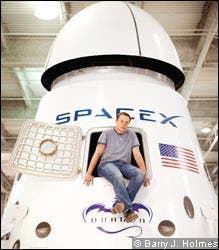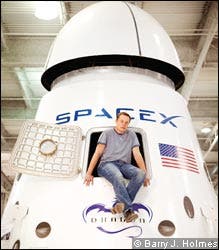
More than just a SciFi dream, Paypal founder and billionaire Elon Musk wants to make “man on Mars” a reality.
Speaking at a recent spaceflight propulsion conference held by the American Institute of Aeronautics and Astronautics on Tuesday, Musk unveiled during his keynote how his company, SpaceX, plans on sending humanity to Mars in coming decades.
“Ultimately, the thing that is super important in the grand scale of history is—are we on a path to becoming a multi-planet species or not? If we’re not, that’s not a very bright future. We’ll just be hanging out on Earth until some eventual calamity claims us,” Musk said.
SpaceX has seen a rapid growth in the past decade, signing a number of commercial contracts with NASA and other big telecom companies for space cargo ferrying and sub-orbital satellite deployment. This December, the company will make its first trip to the International Space Station, possibly paving the way for a longer partnership now that NASA’s shuttle program has been retired. The company, however, has bigger plans in stores, like trips to the moon or Mars.
The task of sending significant cargo and people to Mars is arduous, both engineering-wise and financially.
“There’s a reason no one has invented a fully reusable rocket before,” Musk explained. “It’s super-damn hard.”
At the conference, Musk described several of the recent advances made by his company’s Falcon 9 rockets, which were tested successfully for the first time June 4, 2010. The rocket is designed to generate 3.8 million pounds (1,700 metric tons) of thrust – ideal for carrying satellites, cargo, and even humans to other planets, he said.
Musk has his faith set on another project, however – the Falcon Heavy, the most powerful rocket in the world. The SpaceX rocket has been design to carry about 117,000 pounds (53,000 kilograms) of cargo to orbit, twice as roomy as NASA’s Space Shuttle, and is second in size only to the Apollo program’s mammoth Saturn V. The Flacon Heavy is expected to have its inaugural flight in 2012.
Falcon Heavy is capable of carring 12 to 15 metric tons, but “I think you’ll probably want a vehicle that can deliver something on the order of 50 metric tons … in a fully reusable manner,” said Musk. This means, that we’ll have to wait quite a while before a viable means of space transportation can be discussed. Currently, the Falcon Heavy has a launch cost per pound of $1,000; for a economically feasible round-back trip to Mars the cost would have to be cut under $100.
Musk believes that a single vehicle capable of flying to Mars and back will be available at some time, but if a Mars base would be implemented afterwards, it would change the game dramatically.
“As soon as you’ve got a base on Mars, you’ve got a ‘forcing function’ for improving the transportation capability,” he noted.
“Before the U.S. colonies were established, there was no forcing function for improving trips across the Atlantic. But when there was, there was a need to make those ships better and better,” Musk said
The SpaceX CEO has been repeatedly cited in the public press as intending on putting a man on Mars in the next 20 years. NASA is currently discussing with the company about the possibility of using its Dragon capsule on an exploratory mission to Mars, a so-called “Red Dragon” mission. The Dragon capsule is designed to work in concert with the company’s multistage Falcon 9 rocket, either on short range resupply trips to the International Space Station or on longer range missions to other planets
This elleged Red Dragon mission might be ready to launch by 2018 and would come at the extremely cheap price tag of $400 million or less, which sounds very fairytaleish to me. Musk expects the effort to be a combination of private and government funding, though he said it’s hard to predict what percentage would come from the government.









